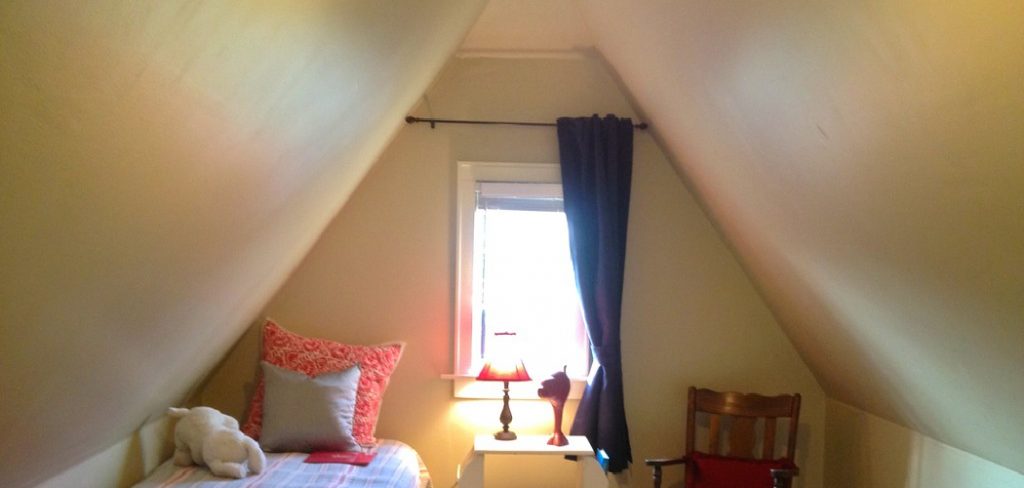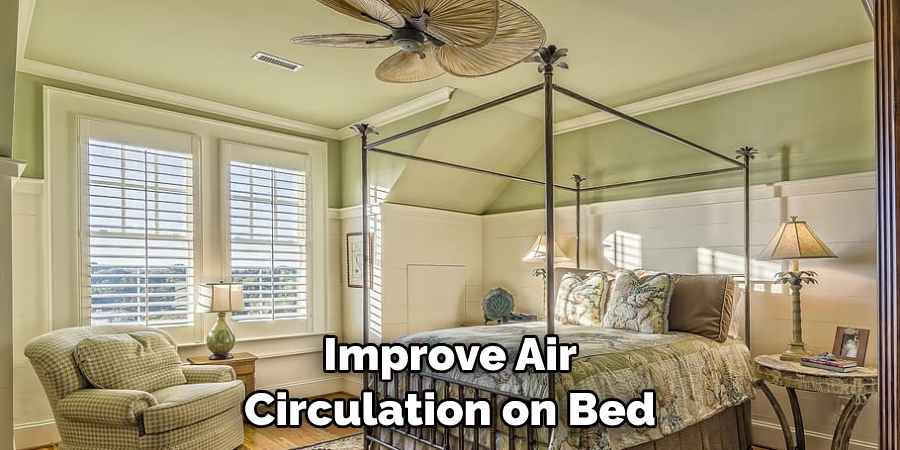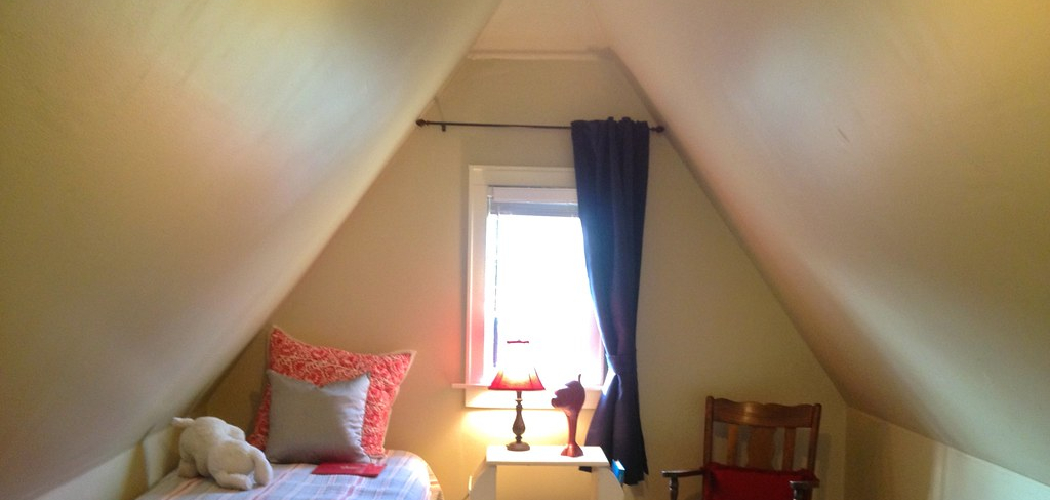Are you looking for ways to keep your attic bedroom cool during hot summer days? Living in an attic can make temperatures very difficult to regulate, but don’t despair! There are many ways to make sure your attic bedroom remains pleasant and comfortable.
In this post on how to cool an attic bedroom, we’ll discuss tips for cooling down an attic bedroom, from proper insulation and ventilation techniques to using air conditioning systems. No matter what method you decide is best for you, these tips will help ensure that your attic stays cool all summer long.

11 Step-by-Step Guidelines on How to Cool an Attic Bedroom
Step 1: Assess the Current Situation
Before you begin implementing cooling strategies for your attic bedroom, it’s important to assess the current situation and understand the factors contributing to the heat. Here’s what you need to do:
Measure the Temperature:
Use a thermometer to measure the temperature in your attic bedroom. This will give you a baseline to work with and help you track progress as you implement cooling techniques.
Identify Heat Sources:
Determine the main sources of heat in your attic bedroom. Common heat sources include sunlight, poor insulation, air leaks, and heat transfer from lower floors.

Check Ventilation:
Assess the ventilation in your attic bedroom. Ensure that there are sufficient vents or windows for air circulation. Also, check if there are any blockages or obstructions limiting the airflow.
Consider Insulation:
Evaluate the insulation in your attic. Insufficient insulation can lead to heat transfer, making the room hotter. Identify areas where insulation may be lacking or damaged.
Step 2: Improve Insulation
Proper insulation is crucial for maintaining a comfortable temperature in your attic bedroom. Seal air leaks: Identify and seal any air leaks in the attic, such as gaps around windows, doors, and electrical outlets.
Use caulk or weatherstripping to seal these areas. Add insulation: If your attic is not adequately insulated, consider adding more insulation. Use insulation materials suitable for your climate and follow the manufacturer’s instructions for installation.
Common options include fiberglass batts, blown-in cellulose, or spray foam insulation. Insulate the roof: Consider insulating the roof of your attic bedroom. This can help reduce heat gain from the sun. Consult a professional to determine the best insulation method for your specific roof type.

Step 3: Enhance Ventilation
Proper ventilation plays a crucial role in cooling your attic bedroom. Ensure that your attic has proper ventilation by installing vents. Ridge vents, soffit vents, or gable vents can promote air circulation and prevent heat buildup. Consult a professional to determine the best venting system for your attic. Use exhaust fans: Install exhaust fans in your attic bedroom to expel hot air.
These fans can be installed in windows or walls and should be strategically placed to maximize airflow. Consider attic fans: Attic fans can help remove hot air from the attic space. These fans can be solar-powered or electric and are typically installed on the roof or gable ends. Consult a professional to determine the appropriate size and type for your attic.
Step 4: Create a Shade
Reducing direct sunlight exposure can significantly cool your attic bedroom. Install blinds or curtains: Install blinds or curtains on windows to block out direct sunlight. Choose light-colored or reflective materials that can help reflect heat away from the room. Use window films: Apply window films to reduce the amount of heat entering through the windows.
These films can block UV rays and minimize solar heat gain. Use shades or awnings: Consider installing shades or awnings on the exterior of your attic bedroom windows. These can provide additional shade and prevent sunlight from directly hitting the glass.
Step 5: Improve Airflow
Promoting airflow within your attic bedroom can help cool the space. Use fans: Install ceiling fans or portable fans to improve air circulation in the room. Ceiling fans should be set to rotate counterclockwise in the summer to create a cooling breeze.
Use floor fans: Place floor fans strategically to help move air around the room. Position them near windows or doorways to draw in cooler air from other areas. Open windows strategically: Open windows during cooler times of the day, such as early morning or evening, to allow fresh air to enter the room. Ensure that there is cross-ventilation by opening windows on opposite sides of the room.

Step 6: Optimize the Cooling System
If your attic bedroom is connected to the central cooling system of your home, optimize its efficiency. Insulate the air ducts running through the attic to prevent heat transfer. Use insulation sleeves or duct wrap to minimize energy loss. Regularly clean or replace the filters in your cooling system.
Dirty filters can restrict airflow and reduce cooling efficiency. Schedule maintenance: Schedule regular maintenance for your cooling system to ensure it is running efficiently. A professional technician can inspect and clean the system, identify any issues, and make necessary repairs.
Step 7: Minimize Heat-Generating Activities
Certain activities can generate heat and make your attic bedroom warmer. Reduce heat-generating appliances: Limit the use of heat-generating appliances, such as computers, laptops, and ovens, especially during the hottest times of the day. Consider using energy-efficient alternatives or relocating them to a different area.
Use energy-efficient lighting: Replace traditional incandescent bulbs with energy-efficient LED bulbs. LED bulbs generate less heat and can help keep the room cooler. Cook outside: If possible, cook outdoors or use a microwave instead of the oven or stovetop, as these appliances can generate a significant amount of heat.
Step 8: Use Cooling Strategies
Implement additional cooling strategies to keep your attic bedroom comfortable. Use a portable air conditioner: Consider using a portable air conditioner specifically designed for small spaces. These units can provide targeted cooling and are easy to install and maintain.
Use a dehumidifier: Excess humidity can make a room feel hotter. Use a dehumidifier to remove moisture from the air and create a more comfortable environment. Use cooling bedding: Choose bedding materials that promote breathability and help regulate body temperatures, such as cotton or bamboo sheets and breathable mattress toppers.

Step 9: Monitor and Adjust
Regularly monitor the temperature in your attic bedroom and assess the effectiveness of the cooling strategies you have implemented. Make adjustments as needed to achieve the desired comfort level. But remember, it can take time for cooling strategies to take effect. With an effective combination of the steps outlined above, you can successfully cool your attic bedroom and enjoy a comfortable living space.
Step 10: Seek Professional Help
If you’re facing persistent cooling challenges in your attic bedroom, consider seeking professional assistance. An HVAC technician or insulation expert can assess your specific situation and provide tailored recommendations for cooling solutions. But also try to reduce the amount of heat-generating activities like cooking and using a laptop or computer.
Utilize energy-efficient lighting and insulation techniques as well. Minimizing the use of heaters during the summer season can be beneficial for cooling an attic bedroom. Additionally, in considering the installing air condition meantime, the units you specifically designed can be small spaces proactive.
Step 11: Safety Precautions
Keep the following safety precautions in mind when implementing cooling strategies in your attic bedroom. Avoid overloading electrical circuits: Ensure that the electrical load from fans, air conditioners, or other cooling devices does not exceed the capacity of the electrical circuit. Consult a professional if you have concerns about the electrical system.
Follow manufacturer instructions: When installing or using any cooling devices or insulation materials, carefully read and follow the manufacturer’s instructions for safe and proper usage. Take precautions when working in the attic: When performing tasks related to insulation or ventilation, take necessary safety precautions, such as wearing appropriate protective gear, working on a stable surface, and avoiding excessive heat exposure.
By following these step-by-step guidelines on how to cool an attic bedroom, you can effectively cool your attic bedroom and create a comfortable living space even during the hot summer months. Remember to assess your specific needs and adjust the strategies accordingly to achieve the best results.
Frequently Asked Questions
Q: How Do I Cool My Attic Bedroom in the Summer?
A: There are several steps you can take to cool an attic bedroom, including using cooling strategies like portable air conditioning, dehumidifiers, and cooling bedding. Additionally, reduce heat-generating activities such as cooking and using a laptop or computer. Minimizing the use of heaters during the summer season can also be beneficial for cooling an attic bedroom.

Q: What Are Good Strategies for Cooling an Attic Bedroom?
A: Effective strategies for cooling an attic bedroom include using a portable air conditioner designed for small spaces, running a dehumidifier to remove excess moisture from the air, and investing in breathable bedding materials like cotton or bamboo sheets and mattress toppers. Additionally, take safety precautions when working in the attic with insulation or ventilation needs.
Q: How Can I Improve the Insulation in My Attic Bedroom?
A: Improving insulation in an attic bedroom can help keep cool air inside and hot air outside. Consider adding insulation to ceilings, walls, windows, floors, and doors, as well as sealing any gaps or cracks. Additionally, check for signs of damage or leaks and make sure your ventilation system is working properly.
Q: What Is The Best Way To Ventilate An Attic Bedroom In The Summer?
A: Proper ventilation helps to reduce heat buildup in an attic bedroom and keeps it cooler during the summer months. Installing a fan or opening windows are some effective strategies for ventilating an attic bedroom. Additionally, consider adding insulation materials like foam board to reduce the amount of hot air entering the room.
Conclusion
Ultimately, cooling an attic bedroom can be a challenging undertaking. It’s important to remember to keep the windows open during the day to improve air circulation and maintain a comfortable, low temperature in the room.
Additionally, installing a fan can work wonders for circulating cool air and keeping temperatures below the desired level. As with any home improvement project, it’s always best to take proper measurements and use energy-efficient materials that’ll help lower energy costs in the long run.
Lastly, on how to cool an attic bedroom, good ventilation is key when it comes to keeping an attic bedroom cozy and inviting throughout the summer months. With these tips in mind, you should now have everything you need to cool an attic bedroom without breaking the bank!
